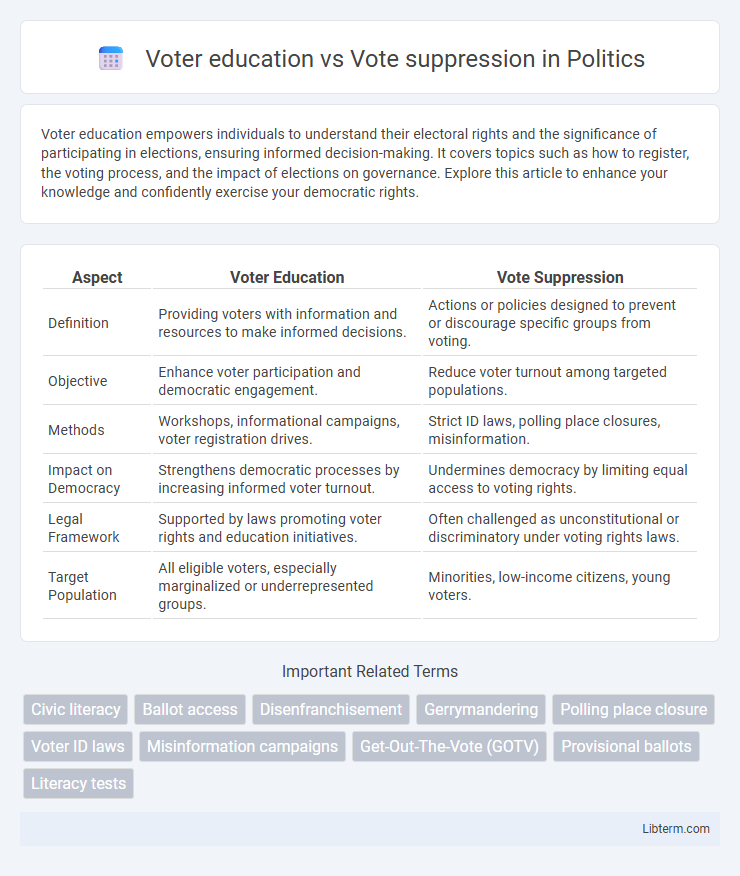Voter education empowers individuals to understand their electoral rights and the significance of participating in elections, ensuring informed decision-making. It covers topics such as how to register, the voting process, and the impact of elections on governance. Explore this article to enhance your knowledge and confidently exercise your democratic rights.
Table of Comparison
| Aspect | Voter Education | Vote Suppression |
|---|---|---|
| Definition | Providing voters with information and resources to make informed decisions. | Actions or policies designed to prevent or discourage specific groups from voting. |
| Objective | Enhance voter participation and democratic engagement. | Reduce voter turnout among targeted populations. |
| Methods | Workshops, informational campaigns, voter registration drives. | Strict ID laws, polling place closures, misinformation. |
| Impact on Democracy | Strengthens democratic processes by increasing informed voter turnout. | Undermines democracy by limiting equal access to voting rights. |
| Legal Framework | Supported by laws promoting voter rights and education initiatives. | Often challenged as unconstitutional or discriminatory under voting rights laws. |
| Target Population | All eligible voters, especially marginalized or underrepresented groups. | Minorities, low-income citizens, young voters. |
Understanding Voter Education: Purpose and Impact
Voter education aims to inform citizens about their electoral rights, voting procedures, and the significance of their participation, enhancing informed decision-making and increasing voter turnout. It combats misinformation and builds trust in the democratic process by providing clear, accessible information on registration deadlines, polling locations, and candidate platforms. Effective voter education directly influences electoral engagement, contributing to more representative governance and reducing the potential impact of vote suppression tactics.
What is Vote Suppression? Key Tactics and Effects
Vote suppression refers to strategies and tactics aimed at discouraging or preventing specific groups of people from voting, often targeting minorities, low-income citizens, and young voters. Key tactics include stringent voter ID laws, purging voter rolls, reducing polling places, and misinformation campaigns that create confusion or mistrust. These methods significantly decrease voter turnout, undermine democratic participation, and skew election results by marginalizing vulnerable populations.
Historical Context: Voter Education and Suppression in Elections
Voter education and vote suppression have shaped electoral landscapes throughout history, with education efforts empowering marginalized communities and suppression tactics systematically disenfranchising them. Key historical moments, such as the Voting Rights Act of 1965, highlight the struggle to eliminate barriers like literacy tests and poll taxes that suppressed African American voters. Ongoing challenges include combating misinformation and restrictive laws that undermine informed participation and equal access to the ballot.
Comparing Voter Education and Vote Suppression Strategies
Voter education strategies focus on increasing electoral participation by providing accurate information on registration processes, polling locations, and candidate platforms to empower informed decision-making. In contrast, vote suppression tactics aim to decrease turnout among specific demographics through restrictive voter ID laws, misinformation campaigns, and limiting access to polling places. Effective voter education counters suppression by promoting transparency and accessibility, thereby reinforcing democratic inclusion.
Legal Frameworks: Protecting the Right to Vote
Legal frameworks such as the Voting Rights Act of 1965 and the Help America Vote Act establish protections against vote suppression by prohibiting discriminatory practices and ensuring accessible voting processes. Court rulings continuously shape the enforcement of these laws, addressing issues like voter ID requirements, redistricting, and polling place accessibility. Effective voter education programs complement legal protections by informing citizens of their rights and navigating complex voting regulations to enhance electoral participation.
The Role of Media in Shaping Voter Knowledge and Access
The media plays a crucial role in voter education by disseminating accurate information about candidates, voting procedures, and election dates, thereby enhancing voter knowledge and participation. Conversely, biased reporting and misinformation can contribute to vote suppression by confusing or intimidating voters, especially marginalized communities. Ensuring media accountability and promoting fact-based coverage are essential for safeguarding voter access and fostering informed democratic engagement.
Barriers to Effective Voter Education
Barriers to effective voter education include misinformation, limited access to reliable resources, and language or literacy challenges that disproportionately affect marginalized communities. Inadequate funding and lack of targeted outreach further hinder the dissemination of critical voting information. These obstacles contribute to voter suppression by creating confusion and disengagement among eligible voters, reducing overall electoral participation.
Detecting and Combating Vote Suppression Methods
Detecting and combating vote suppression methods involves rigorous monitoring of voting laws, identifying restrictive ID requirements, polling place closures, and misinformation campaigns that disproportionately impact marginalized communities. Advanced data analysis and community reporting help uncover patterns like purging voter rolls or limiting early voting access designed to disenfranchise specific groups. Effective voter education programs empower citizens with knowledge about their rights, election procedures, and how to report suppression tactics, thereby strengthening democratic participation and safeguarding electoral integrity.
Case Studies: Successes and Failures in Voter Education vs Suppression
The 2020 U.S. elections highlight the impact of voter education efforts, where states like Georgia implemented comprehensive outreach programs that increased turnout by over 4%, contrasting sharply with restrictive laws in states like Texas that led to a 6% drop in minority voter participation. Case studies reveal that well-funded, community-driven education campaigns in Wisconsin successfully mitigated misinformation and boosted early voting, whereas voter suppression tactics in Georgia, including strict ID laws, suppressed turnout among minority groups by nearly 3%. These contrasting outcomes emphasize how targeted education initiatives can overcome barriers and improve democratic participation, while suppression measures systematically reduce voter access and engagement.
Building a Fair Democracy: Strengthening Voter Empowerment
Voter education plays a crucial role in building a fair democracy by providing citizens with accurate information on voting rights, registration processes, and election procedures, thereby increasing voter turnout and informed participation. In contrast, vote suppression tactics--such as restrictive ID laws, purging voter rolls, and limiting voting locations--undermine democratic principles by creating barriers that disproportionately affect marginalized communities. Strengthening voter empowerment through comprehensive education initiatives and electoral reforms ensures equal access to the ballot, fostering a more inclusive and representative democratic process.
Voter education Infographic

 libterm.com
libterm.com